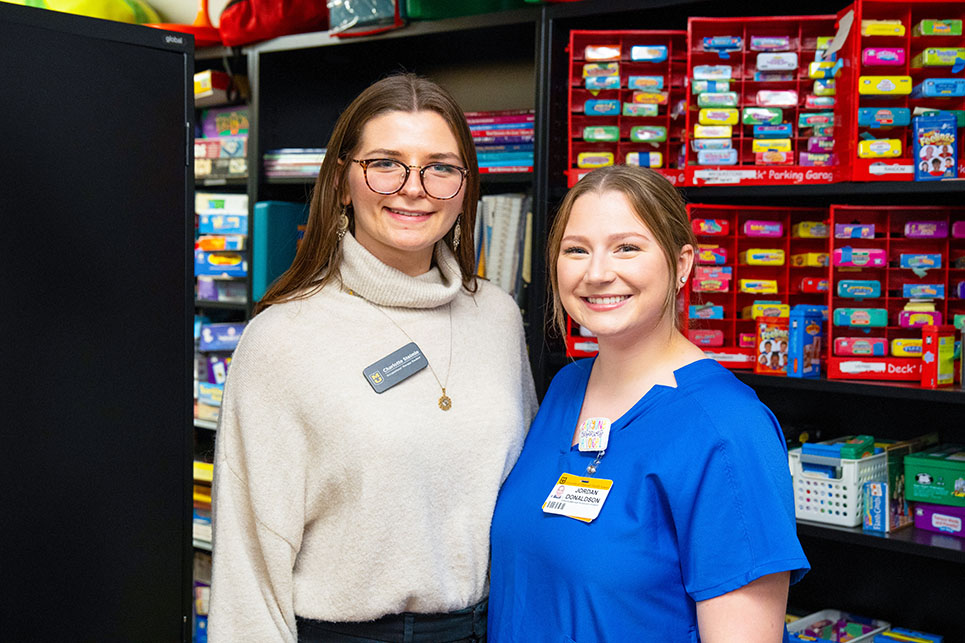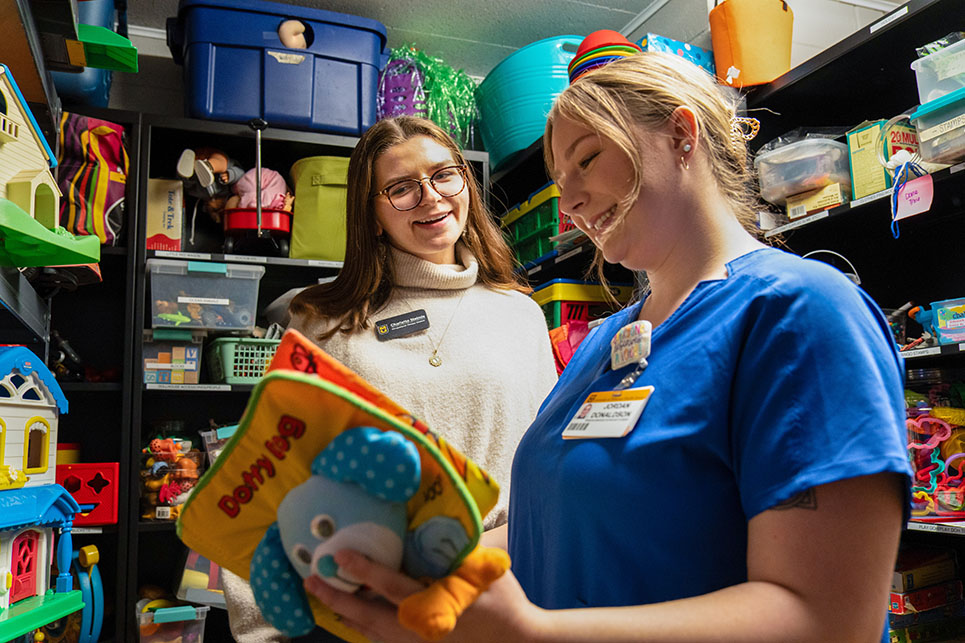Jan. 30, 2024

Story by Cheri Ghan
Two heads might not always be better than one, but it’s certainly the case when it comes to co-treating patients.
The proof is in the pudding. Look no further than a recent collaboration between Charlotte Steimle, an Occupational Therapy doctoral student, and Jordan Donaldson, a Speech, Language and Hearing Sciences master’s student. The partnership between these College of Health Sciences students led to professional growth as well as excellent patient care for a preschooler.
Lea Ann Lowery, a clinical professor in the Department of Occupational Therapy and CHS faculty fellow for interprofessional education, brought together Steimle and Donaldson to gain clinical patient experience. Lowery said they were both excited to work with 3-year-old Tyler Cleveland, who has autism and a birth-related brachial plexus injury that affects the nerves in his shoulder.
Tyler was initially referred to the Robert G. Combs Language Preschool operated by the Department of Speech, Language and Hearing Sciences. After he started in the preschool, SLHS faculty also felt Tyler could benefit from occupational therapy.
Interprofessional education is at the core of the College of Health Sciences, with students from various departments and programs involved in everything from IPE Day and IPE Grand Rounds to an entire course dedicated to interprofessional collaboration.
Steady growth
Throughout their semester-long collaboration, Steimle and Donaldson co-treated Tyler in the MU Speech and Hearing Clinic on Monday afternoons. Tyler had another weekly speech session with Donaldson.
At the beginning of the semester, he was limited to vocal sounds such as “Ahhh” or “Dooooo” and gestures like taking a person’s hand and guiding it to what he wanted to communicate.
“One of the most important goals we worked on was increasing Tyler’s use of various modalities of communication,” Donaldson said. “This includes vocalizations, speech approximations, gestures and other forms of technology to support communication. To reinforce his communicative attempts, we would celebrate his behaviors by clapping and using verbal reinforcement like, ‘Yay! We love to hear your voice!’”
On the OT side of things, Steimle initially focused on self-care activities like learning to wash hands and zip up a jacket. They also worked with Tyler to strengthen his affected arm using weights and a large therapy ball.
“While I supported his positioning from behind, Jordan sat in front of him and helped him focus on us as his play partners,” Steimle said. “During this activity, we could both work on our individual goals while providing a fun and client-centered activity for Tyler. He is a very active child, so it was nice to have another set of hands, eyes and ideas in the room.”
Music presented additional learning opportunities. Tyler loved listening to songs, so Donaldson and Steimle used that to their advantage.
“Music was one way to facilitate numerous communication skills: focus, shared enjoyment and taking turns during conversations,” she said. “It was amazing to see how his face lit up when we started singing.”
Tyler Cleveland Sr. attended his son’s therapy sessions. He would actively observe Donaldson and Steimle’s work, ask questions and learn strategies he could implement at home.
“At first he was very shy,” Cleveland said of his son. “The more he went, the more comfortable he got with it all. I would watch through the window and see them do things that I could copy at home.”

Keeping an open mind
Donaldson said the collaboration would not have been as successful had it not been for Cleveland. The duo appreciated how open he was to different approaches when it came to his son’s treatment.
“After speaking with him about what therapy would be like with both speech and OT, he was always involved in our conversations,” she said.
Midway through the semester, Donaldson introduced an augmentative and alternative communication device (AAC), a tablet-style instrument that uses words and pictures to aid communication. Steimle leveraged that device to work on motor skills with Tyler, noting her experiences underscored the importance of being flexible and adjusting her planned schedule.
“I enjoyed learning how to balance the give-and-take process during an interdisciplinary session,” she said. “Sometimes, Jordan would lead activities and then I would lead some activities. We gave each other the space to work on our separate goals while providing support to each other and Tyler.”
While figuring out what worked best with Tyler, Donaldson and Steimle also had to learn the lingo of one another’s profession. Lowery, who specializes in pediatric occupational therapy, said this sort of shared learning is one of the most important aspects of co-treating.
“What can look so easy from the outside — things like co-creating treatment activities, sharing goals, communicating about how to support a consumer — are actually much more difficult than most developing clinicians realize,” Lowery said. “Our discipline languages often are different, and we might not fully understand the scope of other disciplines’ practice until we work alongside them.”
Cody Higgins, an assistant clinical professor with the Department of Speech, Language and Hearing Sciences, served as Donaldson’s supervising professor. She agreed that poor communication between professions leads to confusion in health care, praising the outstanding care the two CHS students were able to provide to Tyler thanks to their close collaboration.
“Jordan and Charlotte were able to trade ideas and provide additional options during their joint session that may not have otherwise been possible due to the limitations of a single clinician in the room,” Higgins said. “Jordan was able to target communication during play and Tyler’s preferred activities while Charlotte worked to strengthen Tyler’s arm and encouraged positioning that would better serve his mobility during play.”
Donaldson, Steimle and their professors all agreed that putting the patient or client at the center of the co-treatment plan is a key to success.
“No single discipline is more important than another,” Lowery said. “We each serve important roles. Stepping up or back, depending on the client’s needs, is part of excellent health care.”

